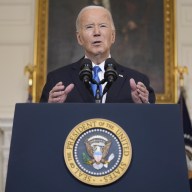 Alfred Molina and John Lithgow finally get to work together in “Love is Strange.”
Alfred Molina and John Lithgow finally get to work together in “Love is Strange.”
Credit: Getty Images
“Don’t eat that bit, babe,” Alfred Molina says to John Lithgow as he’s about to bite into the toothpick in his turkey club sandwich. Molina then laughs, realizing he said it instinctively.
“There’s your lede,” Lithgow jokes.
It seems some actorly affectations are hard to drop. Lithgow and Molina are doing press for “Love is Strange,” in which they play Ben and George, a couple of 40 years who are finally legally able to marry. But when they do, that’s when their troubles begin: George is fired from his church school job, and they’re forced to sell their Greenwich Village apartment. What’s worse, they have to crash in separate houses, staying apart for the first time in decades.
In real life, Lithgow and Molina only mostly knew each other prior to filming. “We were somehow very good friends without ever having spent any real time together or having worked together,” Lithgow says. “Love is Strange” not only pairs them together, it gives two actors known for big, often villainous characters the chance to play small. Here, they discuss their working relationship, the unusual-to-them way their director, Ira Sachs, works and their history making LGBT films.
 In “Love is Strange,” Alfred Molina and John Lithgow get married after 40 years together.
In “Love is Strange,” Alfred Molina and John Lithgow get married after 40 years together.
Credit: Sony Pictures Classics
You two have to convey a long history with each other. How did your friendship help that?
Alfred Molina: It afforded us a sort of ease. John has said it’s no accident that we call it “playing a role.” That’s what we do: We play. Helen Mirren once said as important as the acting are the moments in between acting, when you’re talking with your fellow actors, how you’re getting on. There’s a reason actors are very loquacious with each other — why we’re constantly telling stories, these tales from the trenches. We have to create an intimacy with someone who is possibly a stranger or someone you don’t know too well. But you have to know them for the purpose of the job. You’re acting with someone who’s playing your wife or your husband or your child, and you may have only met them the day before yesterday.
John Lithgow: These parts couldn’t have been played as well if we didn’t have complete ease with each other. And we still have it [on the press tour]. There are very few actors I would want to spend this much time with. [Laughs]
You two also don’t have a lot of scenes together. You’re apart so much that when you get scenes together it makes them that much more special.
AM: It didn’t seem that way to me at first. When I first read the script, I thought it was “Ben and George, Ben and George, Ben and George.” And then when we started shooting, when John turned up I had already done a week’s worth of work, out of a four week shoot. And then after I finished, John was on for another week.
 Alfred Molina’s character in “Love is Strange” is a music teacher who loses his main gig.
Alfred Molina’s character in “Love is Strange” is a music teacher who loses his main gig.
Credit: Sony Pictures Classics
The storyline is superficially reminiscent of “Make Way for Tomorrow,” the 1937 Leo McCarey film in which an elderly couple have to separate because of money issues.
JL: I’ve actually never seen it. It’s been pointed out to me a few times. I think the [Yasujiro] Ozu films were what influenced [Sachs] the most.
You two don’t get many chances to play low-key. How was it working with someone like Sachs, who’s all about tiny moments?
JL: I’ve never worked with anyone who operates the way Ira does. In the month prior to shooting, he traveled up to Calgary, Alberta, where I was working, and he just spent two days with me — just the two of us, one on one, reading through the entire script. He spent time with [Alfred] but he never had us rehearse together. We had supper together, but it was just to get to know each other. There was no read-through. The first time we ever said our lines to each other was when we were on-set. His most frequent direction was “No acting, no acting.” It was like he was taking away the only thing we felt we were good at. [Laughs]
AM: We’re old characters guys. If we see a piece of scenery, we’ll f—ing chew it.
JL: When I saw the movie I said, “Wow, this is a John Lithgow I’ve never seen before.”
AM: That’s exactly how I felt. I thought, this is a new version of me. John and I share something which is we get very excited for roles that take us far away from our own perception of ourselves as possible. Look at the stuff John’s done and the stuff I’ve done: We’re always way off-shore from the island on which we live. And we love that. To me that’s what acting is. This movie we’re playing much closer to who we are as people. Not in any factual way: We’re not gay, we’re not homeless. But emotionally, in terms of how we view the world, we’re playing much closer to who we are. I feel this is some of my best work — and not because I’ve suddenly become this wonderful actor. It’s that it was so easy.
 In “Love is Strange,” John Lithgow plays a painter forced to live with family members.
In “Love is Strange,” John Lithgow plays a painter forced to live with family members.
Credit: Sony Pictures Classics
The film is very gentle too. Scenes play unhurriedly and there are only a few moments of drama.
JL: This is almost non-drama instead of drama. The drama emerges from the ordinariness of their lives.
AM: It’s little moments of ordinariness that actually translate into something quite epic by the end. You witness these tiny increments of emotion and feeling and conflict — all done inside domestic situations, inside interiors. By the end we realized we’d told a universal story.
JL: I do think the film is quite revolutionary, in a sneaky way. It’s such a modest film. But when have you really seen a realistic portrait of an old gay couple? We live in an era when same-sex marriage is this huge front page issue all the time. But there’s nothing in the movies that puts a face on it. The couple in this film is what we’ve been talking about when we say no to Prop 8 or say yes to same-sex marriage.
Both of you played LGBT characters early in your careers: John, as a transgendered ex-football player in “The World According to Garp”; Alfred, as Kenneth Halliwell, Joe Orton’s lover in “Prick Up Your Ears.”
AM: And those were roles in a very different social and cultural climate. They came right in the middle of the first wave of the AIDS crisis. People weren’t nearly as accepting as they are now. We’re a bit spoiled, because in the film business being gay or being openly gay has mostly always been OK. But in the mainstream it’s tough. Those roles, those films had a very different function. That’s what I mean about this being epic in its ordinariness. Those movies were extraordinary and the characters were perceived as extraordinary.
JL: If you look at the list of breakthrough films on gay themes — “Prick Up Your Ears,” “Longtime Companion,” “Milk,” “Philadelphia” — those were about assassinations, death by AIDS, discrimination against homosexuals, fighting for rights and torment. In this film, our crises are tiny. It is a great injustice that George is fired. But that’s in the first few minutes of the film. The rest of the crises are ones we all share. It’s just life. There’s no difference between a gay marriage and a straight marriage.
Follow Matt Prigge on Twitter @mattprigge
















